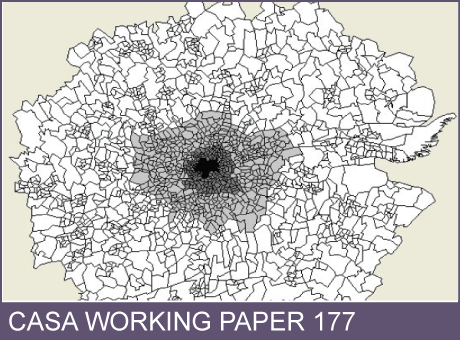CASA Working Paper 177

2 January 2012
Simulating the Spatial Distribution of Employment in Large Cities: with Applications to Greater London.
In this chapter, we first review the development of employment location models as they have been developed for integrated models of land use transportation interaction (LUTI) where the focus is on the allocation of population and employment.
We begin by sketching how employment models based on input-output and multiplier relationships are used to predict future employment aggregates by type and then we illustrate how these aggregates are distributed to small zones of an urban region in ways that make them consistent with the distribution of population and service employment allocated using spatial interaction-allocation models. In essence, the structure we are developing, which is part of an integrated assessment of resilience to extreme events, links input-output analysis to the allocation of employment and population using traditional land use transportation interaction models. The framework then down scales these activities which are allocated to small zones to the physical level of the city using GIS-related models functioning at an even finer spatial scale.
The crucial link in this chain is how we distribute detailed employment types generated from the input-output model to small zones consistent with the way population and services are allocated using the LUTI model. To achieve this, we introduce an explicit employment forecasting model in which employment types are related to functions of floor space that they use. These are estimated using linear regression analysis which enables future predictions of their location to be scaled in proportion to the totals generated from the input-output framework. These future estimates of floor space condition the supply side of the model, and combined with accessibility indicators, provide the heart of the employment location model. We have developed this model for London and its region – south east England – and after presenting the results of the model, we sketch how the integrated framework is being used to generate scenarios for future employment and population change.
Authors: Duncan A. Smith, Camilo Vargas-Ruiz, & Michael Batty
Publication Date: 01/2012
RPS ID:
Download working paper No. 177. File size 990KB, PDF format.
 Close
Close

